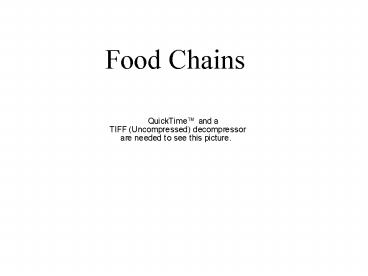Food Chains - PowerPoint PPT Presentation
1 / 40
Title:
Food Chains
Description:
What about animals that eat both plants and animals, such as bears and humans? ... Polar bear. Lemmings, hares, Arctic fox. Plants (berries, lichens, seeds) Lemming ... – PowerPoint PPT presentation
Number of Views:76
Avg rating:3.0/5.0
Title: Food Chains
1
Food Chains
2
- Directions Throughout this presentation, there
will be slides with a blue background (like this
one) and a question. If you know the answer to
this question, raise your hand. - Your teacher will try to decide who raised their
hand first. - If you get it right, your group gains one point.
If you dont know and you make an educated guess,
then your group gets 1/2 a point. If you make an
uneducated guess, meaning you are completely and
utterly wrong, then you get no points. - Fill out the handout with the appropriate answers
and definitions as we go along.
3
- What is a Food Chain?
4
- A food chain is a way to describe the feeding
relationships between different organisms.
5
- What is an organism?
6
- An organism is a living creature, such as a plant
or animal.
7
- And what is a feeding relationship?
8
- A feeding relationship describes who is eating
what in a particular habitat.
9
- Which organisms are able to use energy directly
from the sun to make their own food? - Hint Can animals eat sunrays?
10
- Plants can! Through the process of
photosynthesis they use the energy from sunshine
to make food. - That is why they are called primary producers.
11
- What does produce mean?
12
- All food chains start with green plants because
they can produce food.
13
- The next step up the food chain are the primary
consumers. - These are animals that feed directly on plant
material.
14
- What does consume mean?
15
- To consume is to eat, drink, use, or buy.
16
- What are animals that eat plants called again?
17
- Yep, herbivores.
- Herbivores are primary consumers.
18
- And who eats herbivores?
19
- Carnivores, or animals that eat primary
consumers, are called secondary consumers.
20
- So a food chain shows who eats what in a
particular habitat. - For example, a piece of willow is eaten by a
moose, which is then eaten by a wolf.
21
- The arrows between each item in the chain always
point in the direction of energy flow- in other
words, from the food to the feeder.
22
Who eats what in this food chain?
23
- All food ultimately comes from green plants or
producers. - The other organisms in the food chain are
consumers, because they all get their energy and
biomass by consuming (eating) other organisms.
24
- All food chains are pretty short.
- There are never more than four steps, because a
lot of energy is lost at each step, and after
three steps most of the available energy has been
expended.
25
- What does expended mean?
26
- Energy transfer up the food chain is inefficient.
That means that a lot of it is lost at each
step. - Only 10 of the biomass consumed by an organism
actually becomes biomass of the consumer.
27
- What is biomass?
28
- Biomass is the weight of a living organism.
29
- If a wolf eats 10 pounds of musk oxen meat in one
day, how much of that meat will become wolf
biomass? - Hint Remember the 10 efficiency rule.
30
- If a wolf eats 10 pounds of musk oxen meat in one
day, it will only gain 1 pound. - The rest of the energy is lost.
31
- Which are there more of in Alaska, willows or
wolves?
32
- There are a lot more willows than there are
wolves. - Due to the energy loss at each transfer up the
food chain, there are a lot more organisms lower
in the food chain than up at top.
33
- This also explains why the organisms at the top
of food chains (such as wolves) are very small in
number compared to those lower down (such as
willows).
34
- After 2 steps there is simply not enough
available energy to support more than a few top
predators.
35
- What about animals that eat both plants and
animals, such as bears and humans? What are they
called?
36
- Yes, they are called omnivores.
37
- Even animals that arent omnivores do not usually
only eat one particular organism (can you imagine
eating only one food, like carrots, for example,
and nothing else?!).
38
- Because animals eat more than one type of food, a
better way to show feeding relationships is to
draw a series of interconnecting food chains,
called a food web.
39
Who eats what in this aquatic food web?
40
Can you make a food web showing the feeding
relationships between the following arctic
organisms?































